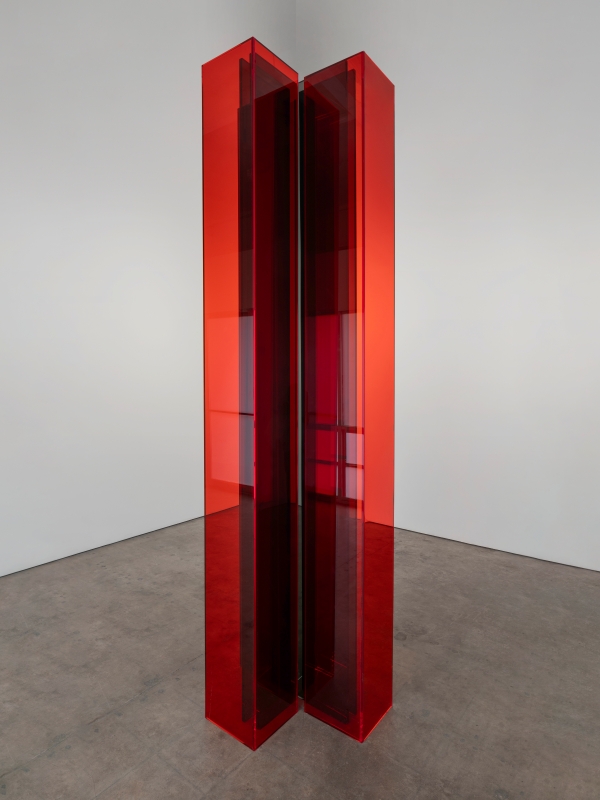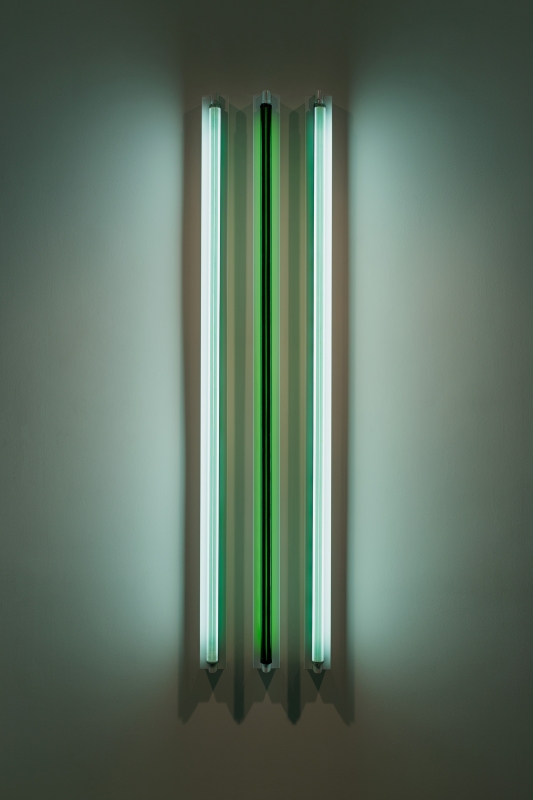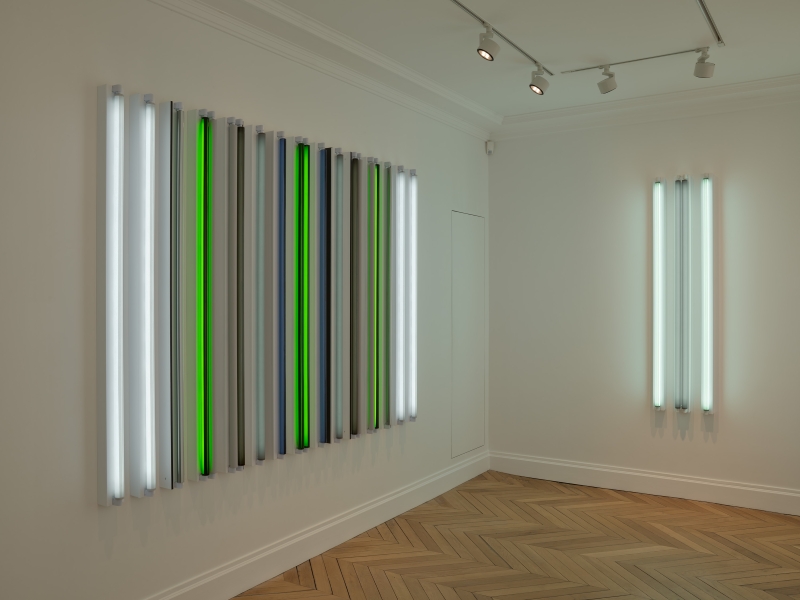Robert Irwin
The exhibition
The White Cube gallery in Paris is producing a monograph on the work of Robert Irwin, a pioneer of the "Light and Space" movement. Born in Southern California in the 1960s, this artistic movement focuses on perceptual phenomena, immersing the viewer in a multi-sensory experience. The gallery presents eight murals and a monumental sculpture created by the artist towards the end of his life. This exhibition offers a striking insight into the practice of Robert Irwin, who profoundly transformed our relationship with art by exploring light and space in a continuous dialogue.
Robert Irwin began his career in the 1950s as an abstract expressionist painter. He soon abandoned painting in favour of light installations, developing a minimalist, sensory and silent art form that engages the viewer in a direct and immersive experience. The exhibition at White Cube reflects this research ‘into our potential to know the world around us and to be actively present in it.’ (Robert Irwin, 2018) He manipulates light using fluorescent tubes, coloured gelatinous sheets and tape, creating veritable luminous compositions. Sedona AZ (2015) is an example of these visual variations, which, through the rhythmic alternation of white, blue, green and yellow tubes, evokes the sunrise in an almost musical harmony. Each work becomes a study in the way we receive light. For Irwin, the piece stands on its own as long as it takes space into account. White Cube has thus blocked up certain windows to allow the installations to unfold their full luminous and perceptive power. Empire #4 (2014-15), composed of seven fluorescent neon lights that gradually diminish in intensity, is an autonomous light sculpture, capable of generating its own contrasts, shadows and halos without any additional source of illumination.
Unlike James Turrell, with whom he shares certain aesthetic affinities, Irwin does not seek to mystify light. His more methodical approach is based on a rigorous mastery of materials and chromatic variations. He also distinguishes himself from Dan Flavin, another major figure in Minimalism, by placing human perception and spatial experience at the heart of his approach*. Where Flavin proposes assemblages of neon lights in a logic close to Marcel Duchamp's ‘ready-made’ - where the object on display is deprived of its primary function, without any apparent transformation - Irwin transcends the industrial luminous panels of large surfaces. He hijacks them to create a poetic plastic material capable of subtly altering our relationship to space and light. Whereas Flavin focuses on the raw presence of light in simple, contextual combinations, Irwin develops an art of active perception, where the work is revealed through the involvement of the viewer. It is no longer a question of signifying, but of perceiving. This is one of his strengths: he has refocused attention on what the eye sees, on what the body feels, on how space, time and light redefine our awareness of the visible. The central installation, Untitled - Faceted (2021), demonstrates this. Composed of six three-metre-high columns of pigmented acrylic, this sculpture invites visitors to move around it. With each turn, the colours - red, green and grey - change. The installation transforms, evolves, fades or lights up, revealing the intensity of the artist's creative gesture, but also the importance of the viewer, who plays a role in activating the work.
With this monograph, the gallery reminds us of the extent to which Robert Irwin has contributed to opening up new artistic horizons. His work, which is at once scientific, realistic and accessible, places perception at the centre of the creative process. By manipulating light like a living material, he encourages us to see differently, to slow down and to feel. His methodical, subtle work creates thresholds of light that appear and disappear. More than a simple advance in the way we look at a work of art, Robert Irwin has redefined what ‘looking’ can mean, from a simpler, more sober and less codified angle.
*Original translation « Irwin’s oeuvre has been driven by his continuous inquiry into human perception and use of space. » Robert Irwin, Light and Space, LAS, exhibition from 5 December 2021 to 30 January 2022, Kraftwerk, Berlin.
Agathe Fumey
Robert Irwin began his career in the 1950s as an abstract expressionist painter. He soon abandoned painting in favour of light installations, developing a minimalist, sensory and silent art form that engages the viewer in a direct and immersive experience. The exhibition at White Cube reflects this research ‘into our potential to know the world around us and to be actively present in it.’ (Robert Irwin, 2018) He manipulates light using fluorescent tubes, coloured gelatinous sheets and tape, creating veritable luminous compositions. Sedona AZ (2015) is an example of these visual variations, which, through the rhythmic alternation of white, blue, green and yellow tubes, evokes the sunrise in an almost musical harmony. Each work becomes a study in the way we receive light. For Irwin, the piece stands on its own as long as it takes space into account. White Cube has thus blocked up certain windows to allow the installations to unfold their full luminous and perceptive power. Empire #4 (2014-15), composed of seven fluorescent neon lights that gradually diminish in intensity, is an autonomous light sculpture, capable of generating its own contrasts, shadows and halos without any additional source of illumination.
Unlike James Turrell, with whom he shares certain aesthetic affinities, Irwin does not seek to mystify light. His more methodical approach is based on a rigorous mastery of materials and chromatic variations. He also distinguishes himself from Dan Flavin, another major figure in Minimalism, by placing human perception and spatial experience at the heart of his approach*. Where Flavin proposes assemblages of neon lights in a logic close to Marcel Duchamp's ‘ready-made’ - where the object on display is deprived of its primary function, without any apparent transformation - Irwin transcends the industrial luminous panels of large surfaces. He hijacks them to create a poetic plastic material capable of subtly altering our relationship to space and light. Whereas Flavin focuses on the raw presence of light in simple, contextual combinations, Irwin develops an art of active perception, where the work is revealed through the involvement of the viewer. It is no longer a question of signifying, but of perceiving. This is one of his strengths: he has refocused attention on what the eye sees, on what the body feels, on how space, time and light redefine our awareness of the visible. The central installation, Untitled - Faceted (2021), demonstrates this. Composed of six three-metre-high columns of pigmented acrylic, this sculpture invites visitors to move around it. With each turn, the colours - red, green and grey - change. The installation transforms, evolves, fades or lights up, revealing the intensity of the artist's creative gesture, but also the importance of the viewer, who plays a role in activating the work.
With this monograph, the gallery reminds us of the extent to which Robert Irwin has contributed to opening up new artistic horizons. His work, which is at once scientific, realistic and accessible, places perception at the centre of the creative process. By manipulating light like a living material, he encourages us to see differently, to slow down and to feel. His methodical, subtle work creates thresholds of light that appear and disappear. More than a simple advance in the way we look at a work of art, Robert Irwin has redefined what ‘looking’ can mean, from a simpler, more sober and less codified angle.
*Original translation « Irwin’s oeuvre has been driven by his continuous inquiry into human perception and use of space. » Robert Irwin, Light and Space, LAS, exhibition from 5 December 2021 to 30 January 2022, Kraftwerk, Berlin.
Agathe Fumey
When
21/05/2025 - 19/07/2025


